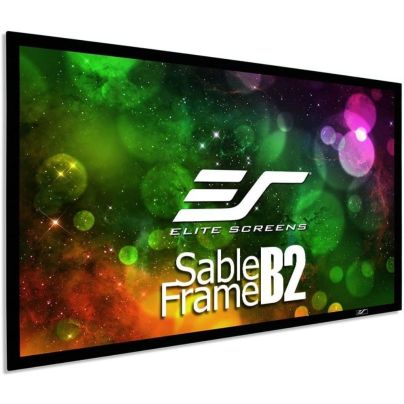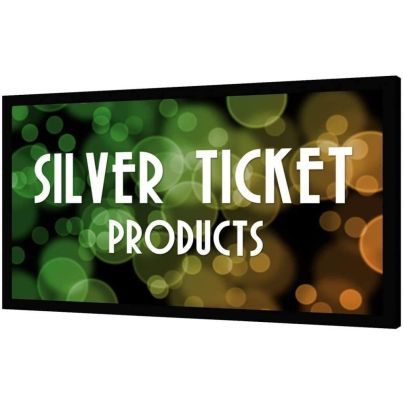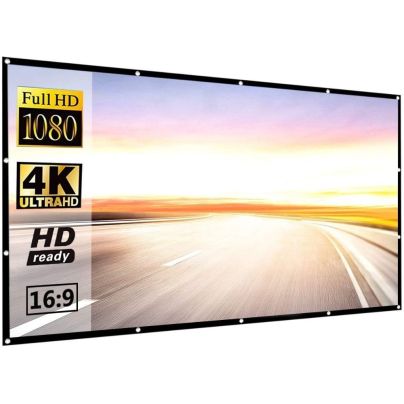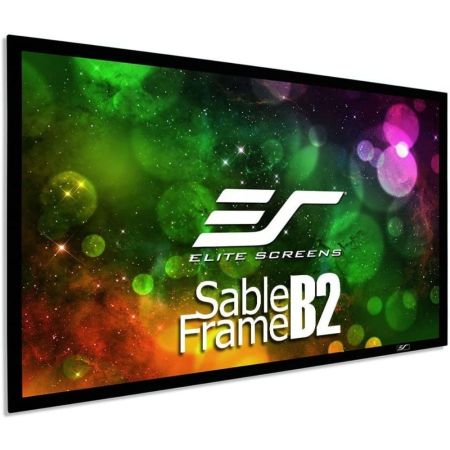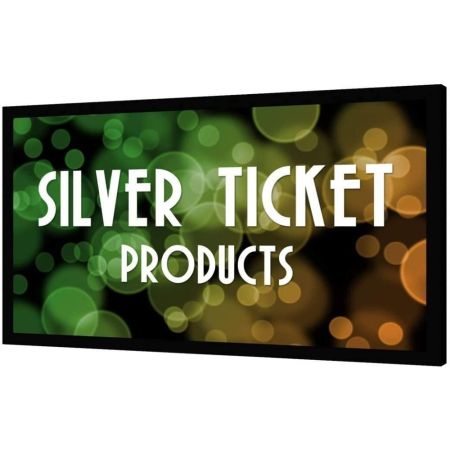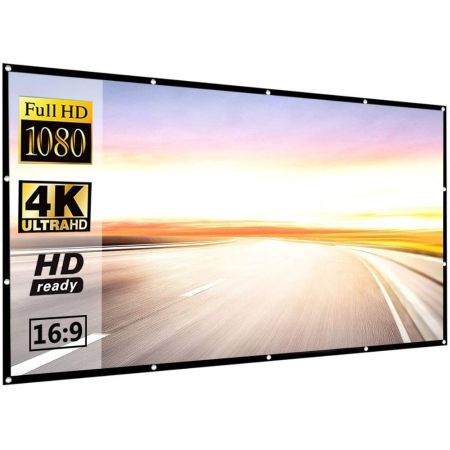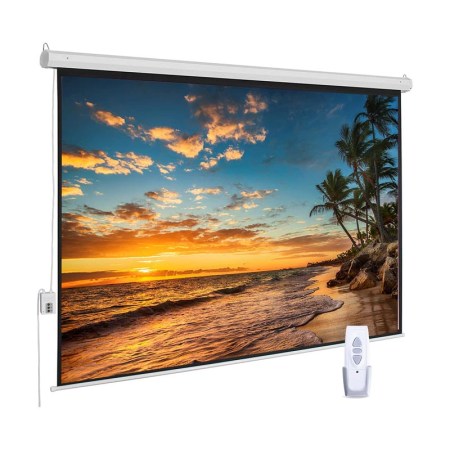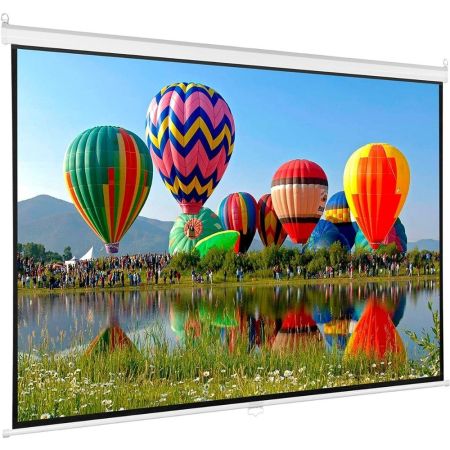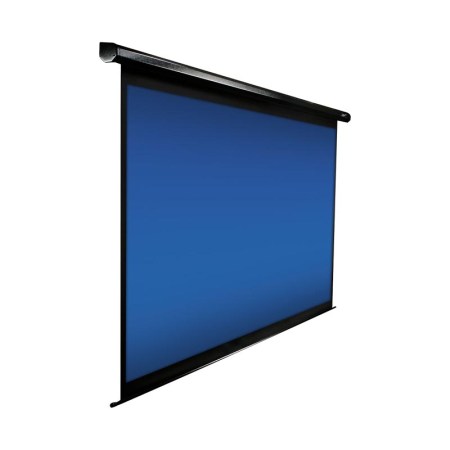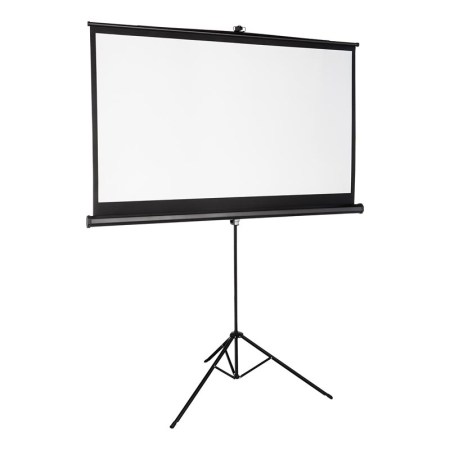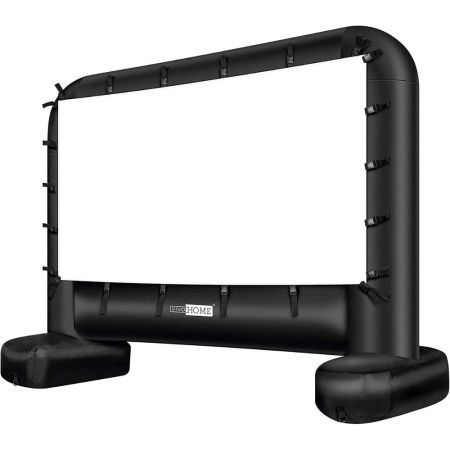We may earn revenue from the products available on this page and participate in affiliate programs. Learn More ›
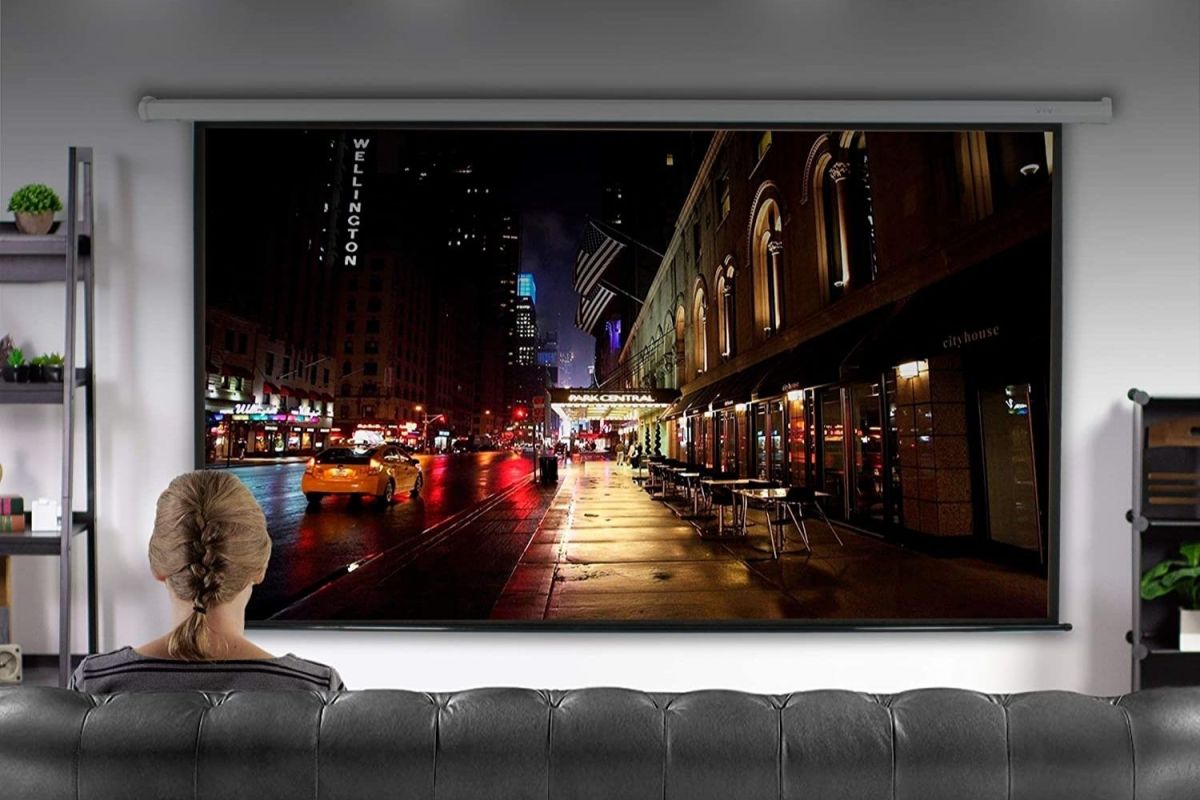
While you may be able to use a sheet or a blank wall to project movies or content from a media streaming device, the benefits of using a projector screen to achieve quality viewing are numerous. Projector screens offer a perfectly smooth and imperfection-free surface that is very difficult to find with a wall. With a screen’s smooth surface, images offer greater clarity and detail for an enhanced viewing experience. Projector screens also can display a brighter image that is much truer to natural colors.
This guide shares key considerations to help you select the right projector screen for your needs. It also includes some of the top projector screens currently on the market.
- BEST OVERALL: Elite Screens Sable Frame B2 120-INCH Screen
- RUNNER UP: Silver Ticket STR-169120 120” 16:9 4K HD Projector
- BEST BUDGET: P-JING 120 inch 16:9 HD Foldable Projector Screen
- BEST VALUE: ZUEDA 100 inch 16:9 HD Motorized Projector Screen
- BEST PULL DOWN: VIVO 100 inch HD Manual Pull Down Projector Screen
- BEST MOTORIZED: Elite Screens Spectrum2 110-inch Motorized Screen
- BEST WITH STAND: TaoTronics 4K HD 100″ Projector Screen with Stand
- BEST OUTDOOR: VIVOHOME 16ft Indoor and Outdoor Inflatable Projector
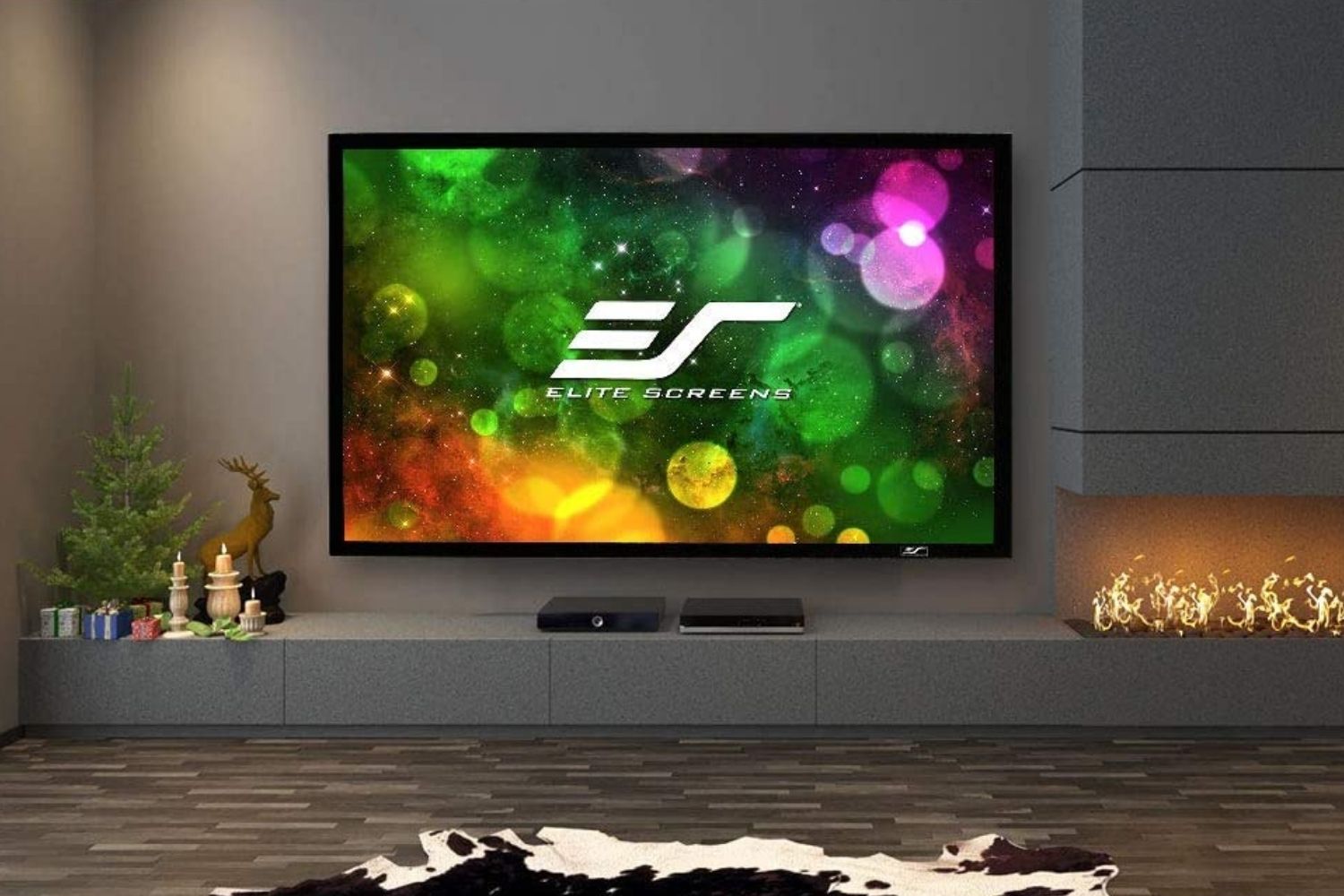
Types of Projector Screens
There are a variety of projector screen types, fixed-frame, foldable, pull-down, floor-standing, inflatable, and rear. Below, learn more about permanent and portable screens to determine which style you prefer.
Permanent
If you plan on using your screen regularly, a permanent model could be a worthwhile investment. High-quality fixed-frame screens bring a sleek, cinema-like look to living rooms, while retractable screens on a patio or beneath an awning can pair with an outdoor projector and speakers.
- Fixed-frame screens are a popular choice for home theatres. They provide better surface tension that enhances image clarity and look similar to flat screen TVs. These wall-mounted projector screens are typically intended for permanent installation and among the more high-end models.
- Pull-down screens function like standard blinds and roll into an upper housing when not in use, then pulled back down for use. These manual fabric screens are suitable for smaller spaces where a permanent projector may take up too much space and are reasonably priced.
- Electric screens are motorized retractable devices that power a similar pull-down/push-up mechanism. Electric screens require adequately sized areas, such as a boardroom or comparable space in a home theater. These large, permanent fixtures can be wall-mounted, ceiling-mounted, or recess-mounted.
Portable
Naturally, portable screens are the most flexible type—they’re lightweight, easier to store, and travel with compared to permanent options. Many include a collapsible stand and come with a carrying case that takes some of the hassle out of travel.
- Floor-standing screens can be used on a permanent basis, but most are relatively small and portable. These screens usually come with a collapsible or height adjustable stand that elevates the screen.
- Foldable screens offer a way around storage limitations and portability issues. These inexpensive screens often contain a fabric viewing surface and little else, sometimes basic hardware for attaching it to the wall. Even larger ones can fold compactly like a sheet or blanket.
- Inflatable screens are an outdoor favorite for backyard movie nights and pool parties. The viewing area on the screen is elevated and supported by an air-filled structure, usually with an electric pump included. These extra-large screens are meant for group viewing, and even the smallest options can make a compact backyard feel unpleasantly cramped.
- Rear screens are made specifically for rear projection, which is when the projector is placed behind the screen rather than in front of it. However, since rear screens require enough space behind them for the projector, this type is generally more suitable for very large entertainment rooms and outdoors.
What to Consider When Choosing the Best Projector Screen
Each projector screen on the market is different. From the overall size to the screen resolution, there are benefits to each screen, depending on the situation. Keep the features outlined below in mind to help select the best projector screen for an indoor or outdoor home theater or entertainment space.
Material
Projector screens are most often constructed from plastic, rubber, vinyl, spandex, polyester, and fiberglass for different components:
- Viewing surface: Vinyl and spandex are the preferred fabrics for freestanding and portable screens. These flexible materials don’t require tension to lay flat and are naturally wrinkle resistant. Vinyl is stronger and more water resistant than the alternative, polyester, which is also detrimental to the environment. With permanent screens, fiberglass fabric boosts reflective capabilities for superior contrast. Additionally, some projector screens are treated with active compounds that make light on the viewing surface easier to see.
- Backing/frame: Some permanent screens contain a stiff black backing made of fiberglass, which creates the most tension and the flattest viewing surface possible. Others feature an aluminum backing covered in velvet or fabric; the material is lightweight, affordable, and reasonably strong (prone to minor dents and damage). The backing absorbs overhead and rear light to enhance color contrast and improve image quality.
- Stand or base: Aluminum is often used in the bases of floor-standing projector screens. It’s lightweight yet sturdy and highly weather resistant, so aluminum is well-suited for portability and outdoor viewing conditions like wind or rain. With inflatable models, a PVC plastic or rubber structure supports the screen, both tough materials that can handle variable weather.
Dimensions
Determining which screen size is right for your space is important before getting too deep into your search. Consider the guidelines below when measuring for indoor and outdoor projectors:
- Measure the area where the screen will be placed to see the amount of space that is available.
- Keep in mind that the base of the screen is usually 3 to 4 feet off the ground so those sitting in a back row will still be able to see the entire picture.
- For indoor spaces, the top of the screen should be at least 1 foot down from the ceiling to keep individuals from straining to look up too high to see the images.
- Aim to have the first row about twice as far from the screen as its height and the last row up to eight times as far as the screen’s height. For example, if a screen is 10 feet high, the front row should be located about 20 feet from the screen, and the last row as far as 80 feet away.
- Find out which screen sizes are compatible with the projector. Some projectors won’t be able to project a clear image onto a large screen and a smaller image will end up on a large screen, which could look out of place.
Manual vs. Motorized
Many projector screens have a retractable design. These retract when not in use to stay out of sight. When choosing a retractable projector screen, there’s a choice between a manual or a motorized option. Each has its own pros and cons to consider.
- Manual projector screens are less expensive than motorized options. They also weigh less, which can make them easier to securely mount to a wall. However, manual screens can become a nuisance to pull down and retract if they are used regularly. They are also more likely to develop ripples or creases than motorized screens. Choosing a tensioned manual projector screen with wires or rods to keep the screen material taut or one featuring anti-crease technology can help reduce the chance of creases or wrinkles.
- Motorized projector screens are easier to operate and can be pulled down or retracted into their case with just the push of a button. These models also make it easier to control exactly where the base of the screen will stop, which can be a benefit if there are items on the wall under the screen. The rolling mechanism on a motorized screen typically lasts longer than the mechanism on a manual model due to less stress being placed by not pulling the screen. Tensioned motorized projector screens are available to help ensure the screen stays completely flat. A downside of motorized projector screens is that they are more expensive than manual models.
Screen Color and Resolution
The color and resolution of a projector screen affect how the images display. Projector screens are available in three color options: white, gray, and black.
- White: White projector screens are the best choice for displaying more vivid colors. However, if a room isn’t fully dark and has ambient light, it can be challenging to view the image on a white screen. White screens generally cost less than gray or black screens. They usually are a better choice for an office environment or other uses where slides and other text will be displayed.
- Gray: Gray screens offer a better option for rooms where more ambient light is present. Unlike white screens, they are able to reject ambient light, which makes it easier to see images in rooms that aren’t completely dark. However, compared to white screens, the viewing cone of a gray screen is often narrower than that of a white screen. Gray screens are often the best choice for an outdoor projector screen since it will absorb more light than white screens but still allow other colors to be displayed properly.
- Black: Black projector screens are also able to reject ambient light. Dark colors and blacks appear really deep on a black screen, but whites and lighter colors may not look as accurate.
Resolution also is important to consider when shopping for the best projector screen. If using a 4K or high-resolution projector, a high-resolution projector screen will help get the benefits of the projector. Without the ultrasmooth surface of a 4K screen, the images from the 4K projector won’t reach their full potential.
Pay close attention to the aspect ratio of each screen as well. A 16:9 aspect ratio, also referred to as HDTV format, is the best choice for watching television or streaming videos from streaming services. A 16:10 aspect ratio is best for projecting information from a computer for office applications, conference rooms, or trade shows. A 2.34:1 aspect ratio is ideal for enjoying a vintage movie-viewing experience, while a 2.40:1 aspect ratio would offer a more contemporary movie-viewing experience.
Screen Gain and Viewing Angle
Gain is a unit that measures the brightness of the image that is reflected off of the projector screen. Gain is the ratio of the light reflected back from the projector, which is the light source. Screens that offer a gain measurement that is more than 1.0 yield a brighter image than what is being projected. As an example, projector screens with a 2.0 gain would yield an image that is perceived as 2,000 lumens from a 1,000-lumens projector.
While screens with a high gain are brighter, they aren’t ideal for areas where a wider viewing angle is needed. The higher the gain, the narrower the viewing angle. This means a projector screen with a lower gain would be best for spaces with a wide row of seats. A lower-gain screen is also better for displaying vivid black colors.
Our Top Picks
Keep reading to explore some of the best projector screen options on the market. These products, which were selected using the aforementioned criteria, come from a variety of manufacturers and satisfy a range of budgets.
Best Overall
Elite Screens Sable Frame B2 120-INCH Screen
See ItIndividuals looking for a projector screen that will deliver vibrant images with excellent color reproduction may want to consider the 120-inch Sable Frame projector screen from Elite Screens. This screen has a high-quality CineWhite screen that is 4K Ultra HD and Active 3D ready. The screen has a 1.3 gain with a 160-degree viewing angle. Regardless of the seat viewers choose, they’ll enjoy a bright image with high resolution. It has a 16:9 aspect ratio.
This wall-mounted projector screen is designed to be easy to install. It features a tension rod and spring system to ensure the CineWhite material remains wrinkle-free for first-class viewing experiences. The screen material is framed with a black-velvet-covered aluminum to absorb overshoot and help frame each image. Sliding wall brackets, drywall anchors, and screws are included for mounting the screen to a wall. Available through Amazon and BestBuy.
Runner Up
Silver Ticket STR-169120 120” 16:9 4K HD Projector
See ItSilver Ticket’s 120-inch HD screen has a 1:1 gain that provides a wide viewing angle of 160 degrees. This wider angle helps ensure that all individuals, regardless of where they sit, will be entertained and able to enjoy movies, television shows, videos, and more without compromising picture quality or resolution. This is a white screen made using a quality vinyl material, the same material used for professional projection screens. It has a 16:9 HD aspect ratio.
This fixed-frame screen can be mounted to a wall in a home entertainment room, and it is designed to offer a quick and easy assembly with pockets to slide the rods for framing the screen. The tension rod design also helps ensure that the screen material will be taut, perfectly squared, and free of wrinkles. The aluminum frame is wrapped with black velvet to absorb any light that is overprojected. This feature helps with properly aligning the image from the projector within the screen. Available through Amazon and Walmart.
Best Budget
P-JING 120 inch 16:9 HD Foldable Projector Screen
See ItThis 120-inch projector screen can be an optimal choice for those looking for a portable option. The 2.2-pound screen can fold when not in use, so it is compact and lightweight for easy storage or transport. Once ready to use, simply hang it up using the metal grommets along the reinforced border. The wrinkle-free material ensures a smooth screen without any creases, even after folding.
This projector screen has a 16:9 aspect ratio and can be used both indoors and outdoors with front or rear projectors. It offers a 160-degree viewing angle with a low gain and a thick matte white surface to help all viewers enjoy clear images without light penetration. Each purchase includes a 16-pack of peel-and-stick hooks and two 5-meter ropes. The projector screen is compatible with most LCD, LED, or DLP projectors. Available through Amazon.
Best Value
ZUEDA 100 inch 16:9 HD Motorized Projector Screen
See ItThis 100-inch projector screen from Zueda is a budget-friendly option that offers a lot of great benefits. A pre-wired power cord is integrated into the design of the screen and allows for motorized operation using the control panel or remote control. The screen has a 1:1 gain with a wide 160-degree viewing angle. It offers top-quality image reproduction due to the yellow-staining- and wrinkle-free matte white finish.
This projector screen offers a 16:9 aspect ratio. It can be used with a variety of projector types including LCD, LED, and DHP models. The screen retracts into a solid metal silver casing when not in use. The casing is designed for both wall or ceiling installation options to provide flexibility with room layout and planning. Available through Amazon and Walmart.
Best Pull-Down
VIVO 100 inch HD Manual Pull Down Projector Screen
See ItVivo’s 100-inch projector screen offers a simple pull-down design that allows the screen to retract out of the way when it is not in use. Simply tug on the small handle at the base of the screen to pull it down for use or to send it back into its casing. The design features a self-locking height adjustment to help set the screen to the desired location.
The projector screen is made from a multilayer matte white material that diffuses light in all directions to display high-quality images. The black backing works to prevent light from penetrating the screen to further enhance image quality. The screen has a 1:1 gain and a 120-degree viewing angle. It has a 16:9 widescreen aspect ratio and is compatible with most DLP, LCD, or LED projectors. Available through Amazon and Walmart.
Best Motorized
Elite Screens Spectrum2 110-inch Motorized Screen
See ItEnjoy the simplicity that comes with having a motorized projector screen with the Spectrum2 110-inch screen from Elite Screens. Individuals can easily raise or lower the screen using the three-way integrated control switch or purchase the optional remote control kit.
This screen features a MaxWhite finish with a fiberglass backing for optimal image resolution with a 1:1 gain. It is 4D Ultra HD and Active 3D-projection ready and offers an impressive 180-degree viewing angle to ensure each member of the audience has the best seat in the house. The screen material is GreenGuard Gold Certified. The screen’s casing is constructed from a durable and sleek steel material. Each purchase includes an installation kit and floating mount brackets for mounting it to a wall. Available through Amazon and BestBuy.
Best with Stand
TaoTronics 4K HD 100u0022 Projector Screen with Stand
See ItThe TaoTronics projector screen comes with a tripod support stand and carrying bag for easy transport, storage, and setup. The screen can be set up and ready to use or rolled up and put back in the case in as little as 2 minutes. Individuals can adjust the height of the screen using the knobs and controls on the back.
This projector screen features three-layer construction. The top layer is a PVC matte white material that is wrinkle-free and resists yellow staining to ensure crisp and clear images. A polyester layer and black back layer also are included to enhance the image quality and keep light from penetrating the screen. This low reflective screen offers a 1:1 gain and 160-degree viewing angle. Available at BestBuy.
Best Outdoor
VIVOHOME 16ft Indoor and Outdoor Inflatable Projector
See ItHave a blast with VIVOHOME’s blowup projector screen while hosting outdoor movie nights or other outdoor events. This 17-foot screen comes with a fan pump to blow up the screen and keep it inflated while in use. The fan operates quietly so as not to distract from the viewing experience. A storage bag, 250-watt air blower, and yard stakes are included with each set.
This inflatable projector screen is made from a high-quality 210D Oxford cloth that is durable and weather resistant. It features wide feet to ensure stability and straps that can be adjusted to flatten the screen for a smooth projection surface. The screen has a 16:9 aspect ratio and can be used with either front or rear projection. Available through Amazon.
FAQs
Q: How do I know what size projector screen I need?
There are two main factors that can help determine which projector screen size is right for you. First, measure the wall or area where you plan to place the screen. Aim to leave 3 to 4 feet of space below the screen and 1 foot of space above it. However, in some cases, the maximum-size screen that fits the space may not work with the projector you have. Check the manufacturer’s specifications to confirm which screen sizes are compatible with the projector.
Q: Do I need a special screen for a 4K projector?
If you want to take full advantage of the advanced technology and sharp images possible with a 4K projector, purchasing a 4K screen is a good idea. These screens will feature a completely smooth texture, as opposed to a matte texture, which will allow 4K images to show up more clearly and with less distortion.
Q: What makes a good projector screen?
A “good” projector screen may be different for each user. The right projector screen for you will be appropriately sized for the space, offer the right amount of gain for your seating arrangement, and have a color that works with the lighting characteristics of the space. Whether you prefer a fixed frame screen or one that is retractable also will affect which screen is best.
Q: Is black or white better for a projector screen?
Black and white screens each have different applications. White screens are ideal for rooms with little to no ambient light. Since white screens are brighter, they are better able to display more vivid colors. Black screens are an optimal choice for rooms where there is more ambient light and individuals can’t create a true theater room. Since they don’t reflect as much light as a white screen, images are easier to view with more background light. However, in some cases, a more powerful projector may be necessary with a black screen.
Q: Do you need a dark room for a projector?
No, you don’t need a completely dark room for a projector. However, darker rooms will yield higher-quality images.
